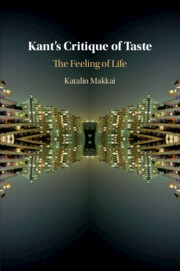Book contents
- Kant’s Critique of Taste
- Kant’s Critique of Taste
- Copyright page
- Contents
- Acknowledgments
- Note on Citations
- Introduction
- Chapter 1 The Art of Judgment
- Chapter 2 Communication and Animation in the Judgment of Taste
- Chapter 3 Subjectivity and Recognition in the Judgment of Taste
- Chapter 4 Modes of Attunement
- Chapter 5 Aesthetic Liking
- Bibliography
- Index
Chapter 4 - Modes of Attunement
Published online by Cambridge University Press: 07 April 2021
- Kant’s Critique of Taste
- Kant’s Critique of Taste
- Copyright page
- Contents
- Acknowledgments
- Note on Citations
- Introduction
- Chapter 1 The Art of Judgment
- Chapter 2 Communication and Animation in the Judgment of Taste
- Chapter 3 Subjectivity and Recognition in the Judgment of Taste
- Chapter 4 Modes of Attunement
- Chapter 5 Aesthetic Liking
- Bibliography
- Index
Summary
This chapter turns to the question of how the judgment of taste is related to cognition and to the larger conception of judgment discussed in Chapter 2. It offers a new reading and contextualization of the argument of §21, in the Fourth Moment of the Analytic of the Beautiful, which establishes a “common sense” as a necessary condition of the universal communicability of cognition. On my reading, Kant does not provide, or seek to provide, a deduction of the judgment of taste avant la lettre. His point, instead, is to show that cognition involves its own form of reflective judgment. Cognitive judgment considered from the perspective of the third Critique – actual, situated judgment – depends on a norm beyond that of correctness: of aptness or appropriateness; of what calls for judgment. My reading is an alternative not only to the widespread “aesthetic” construal of Kant’s argument, on which it is meant to establish an aesthetic common sense, but also to the “epistemic” construal proposed by Henry Allison, on which it is meant to establish an epistemic common sense.
Keywords
- Type
- Chapter
- Information
- Kant's Critique of TasteThe Feeling of Life, pp. 137 - 167Publisher: Cambridge University PressPrint publication year: 2021

